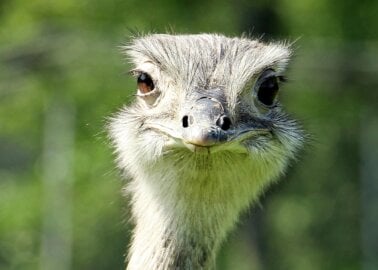10 Reasons Not to Wear Wool
Many people have never considered the impact that the production of wool garments has on the animals whose fleece is used. Sheep are gentle individuals who – like all animals – feel pain, fear, and loneliness, yet the wool industry treats them as nothing more than wool-producing machines, showing them little to nothing in the way of respect and compassion. Here are 10 reasons why we shouldn’t wear wool:
- Sheep are abused for wool.
PETA and its international affiliates have exposed the rampant cruelty in shearing sheds across Australia, South America, the US, and the UK. In PETA Asia’s recent investigation of UK shearing sheds, sheep were seen being beaten, stamped on, thrown, and mutilated by workers. This abuse is standard in the wool industry.
- Lambs face terrifying procedures – without any painkillers.
Castration and tail-docking are just a couple of the painful mutilations that lambs are forced to endure, often without any painkillers. A tight rubber ring is placed around male lambs’ scrotums, and sharp tools are used to cut out their testicles. By the time lambs reach just 6 weeks of age, workers cruelly cut part of their tails off as they tremble in terror. In Australia, ina barbaric procedure called “mulesing”, workers force lambs onto their backs, restrain their legs between metal bars, and carve huge chunks of flesh from their backsides. Instead of bonding with their mothers and exploring their surroundings, as they would in their natural environment, these terrified lambs are subjected to a living nightmare. Patty Mark / ALV.org.au
Patty Mark / ALV.org.au - Shearers work at reckless speeds.
Shearing isn’t just a haircut. It’s usually a violent, horrifying experience for sheep. Shearers are generally paid by volume, not by the hour, which encourages them to work as quickly as possible. And in Australia – the world’s top wool producer – illegal drug use is rife in the industry. Workers recklessly shear as many as 200 sheep a day – leading to rough handling and frequent injuries to the animals. Sheep are commonly deprived of food and water for 24 hours before they’re shorn so that they’ll put up less resistance.
- Millions of sheep die from exposure each year.
Sheep are shorn in the spring, just before some breeds would naturally shed their winter coats. However, many are shorn prematurely, leaving them exposed to harsh weather conditions without any protection from the cold. To make sure that they always have enough sheep to make a profit, farmers simply breed them to bear more lambs in order to offset the deaths.

- Wool is one of the most environmentally damaging materials.
According to the groundbreaking “Pulse of the Fashion Industry” report, wool is one of the four most environmentally damaging materials. Since it’s one of the lucrative co-products of the unsustainable meat industry, this is hardly surprising. Land has been cleared and trees have been cut down to make room for grazing sheep, which has led to erosion, increased soil salinity, and decreased biodiversity. Here in the UK, environmentalists are highlighting the negative impact of sheep farming on the land.
- Sheep are gentle, loving, intelligent animals.
Studies have proved that sheep are gentle, sensitive animals who are not only emotionally complex but also highly intelligent. Just like humans, they visibly express emotions – showing signs of depression when they experience stress or isolation – and they can recognise different facial expressions in humans. Like dogs, they wag their tails when stroked, and they’ve been known to nuzzle humans affectionately in order to get their attention. Sheep all have unique personalities, and they don’t deserve to suffer horrifically in the wool industry.

- Sheep don’t naturally need to be shorn.
It’s a myth that sheep would overheat if they weren’t shorn. In nature, they produce just enough wool to protect themselves from extreme weather conditions. They only grow excessively heavy fleeces when humans breed them specifically to do so, which can cause them to suffer from infections.

- Every sheep used for wool will eventually be sent to slaughter.
The misery isn’t over for sheep even once their wool production declines. Each year, millions of them are exported to other countries on extremely crowded, filthy, disease-ridden ships to face a terrifying slaughter. These live-export voyages often last weeks, during which many sheep perish as a result of the appalling conditions on board. When the survivors arrive at their destination, they’re typically dragged from the ships and thrown into the backs of lorries and cars. Most animals’ throats will be cut while they’re still conscious.

- Rabbits also suffer for wool.
Angora rabbits are exploited for the wool industry, too, as their soft fur is used as angora wool. These gentle, socially complex animals are typically kept inside small, filthy, bare cages and face the ordeal of live plucking up to four times a year. During this process, they’re often physically restrained as workers tear out their hair, leaving only the fur on their heads. PETA’s exposé of Chinese angora farms reveals the horrifying screams the rabbits make while being plucked, a process they’ll endure repeatedly for two to three years before ultimately being killed.

- We can stay warm with cruelty-free wool alternatives.
Buying garments made of wool is bad for animals and the environment. But fortunately, as people are becoming increasingly concerned with the way their clothes are made, there are more alternatives to wool now than ever before Some durable, warm, and stylish alternatives include organic cotton, hemp, and synthetic fibres – and you can even buy fleece made from recycled plastic bottles! To find brands that sell fashion-forward wool alternatives, take a look at our list of companies using the “PETA-Approved Vegan” logo.

What You Can Do
The best thing that you can do for sheep is to refuse to buy wool. It’s easy to check labels and tags before you buy clothing and other items. If they mention “wool”, leave the item on the shelf and look for an animal-free alternative.
Please share this list to help more people learn the truth about the cruelty of the wool industry:



